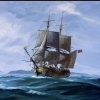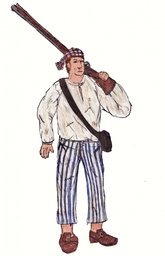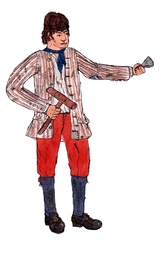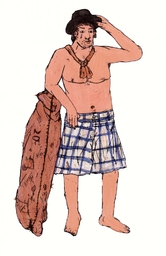-
Posts
1,118 -
Joined
-
Last visited
Content Type
Profiles
Forums
Events
Gallery
Everything posted by Swashbuckler 1700
-

That "X" of cord on the side of a tricorn
Swashbuckler 1700 replied to Ivan Henry aka Moose's topic in Captain Twill
Interesting that I always pick up the trivial things without any define reason. An why always the hats.... Looking old portraits of naval officers alike or in this case politicians I am starting to wonder for what purpose there is so many buttons on hats. Were they just for decoration or for some other purpose like to keep the hat in shape. But since the button is only on the one side it seems to be for beaty purposes... Circa 1709 Or indeed Blackbeard in this 1724 picture (while it is imagined the hat is real but did the Bb had that kind of hat well it is a different matter) -

Leather Capps faced with Red Cotton, and lined wit
Swashbuckler 1700 replied to Gentleman of Fortune's topic in Captain Twill
Well I have found this portrait of a Greenwich pensioner in 1709 Might that cap be made from leather? -
Well I found this picture by accident some time ago there we have early glasses with some sort of frames or laces: Luis de Velasco II, Marqués de Salinas, circa 1607
-
A Dutch caricature of the battle of Cap de la Hogue circa 1692 Figures from left to right. A Dutch seaman, a surrendered French admiral, An English naval officer, a surrendered French naval officer. Scanned from an history book but this should be a public domain image.
-
Well yes I knew somebody would pick up on that. Yes true but... Well I dare to claim that gunner did other task as well and they did not spent all of their their time just beside the cannons.... Well yes he might have just cleaned the cannons or that bucket was there just for waste etc... But for cleaning the ship: There is a Dutch caricature of a Dutch sailor in 1692. There the sailor has a sailor's knife and a besom that does not look like a mop. Of course the caricature is not the best source but the sailor figure seems to be realistic in it. I am trying to find that picture online... There is also an English and French Navy officers in that picture. Oh that besom thing was just to say that cleaning might have been done just like in houses with wooden floor on land. In any case and with any sort of reasoning the deck cleaning in Gaop seems to be an axiom and the bare foot sailors were only occasionally seen during the age of sail.
-
Well yes I knew somebody would pick up on that. Yes true but... Well I dare to claim that gunner did other task as well and they did not spent all of their their time just beside the cannons.... Well yes he might have just cleaned the cannons or that bucket was there just for waste etc... But for cleaning the ship: There is a Dutch caricature of a Dutch sailor in 1692. There the sailor has a sailor's knife and a besom that does not look like a mop. Of course the caricature is not the best source but the sailor figure seems to be realistic in it. I am trying to find that picture online... There is also an English and French Navy officers in that picture.
-
There is no issue about deck scrubbing but since it does not appear easily in accounts etc: Well at least the period pirate literature raises hints of the cleaning things. Like here: I wonder what was Mr Moor(e) doing on deck and with the bucket near him if he was not cleaning the deck (and for what purpose there would have been a bucket handy to Kidd on the deck in the first place): From: The history of the pyrates: containing the lives of Captain Mission. Captain Bowen. Captain Kidd ... and their several crews 1728 edition "Moor, the Gunner, being one Day upon Deck, and talking with Kid[d] about the said Dutch Ship, some Words arose betwixt them, and Moor told Kid[d], that he had ruin'd them all; upon which, Kid[d], calling him Dog, took up a Bucket and struck him with it, which breaking his Skull, he died the next Day." Thought while the deck cleaning in Gaop seems to be an axiom we still have nothing about the sand-stones. And still suck with bare- foot sailors and actually I noticed that if we rely to old pictures, the bare foot sailor is a rare to find even in Napoleonic era prints and paintings. Still not impossible. For example here it seem that of the three easily visible man two have shoes or slippers(?) and the one on right has bare feet. http://collections.rmg.co.uk/collections/objects/147299.html Still there is nothing that would give an impression of an really universal habit of not wearing shoes on ship in the era of sailing ships. Some preferred it that way and if the weather was warm there was nothing to stop sailors of doing so but the shoes were apparently more comfortable, at least when on rigging and when the weather was not so kind.
-
Modern pictures but they represent late XVII (17th) century French sailors The first one (the term uniform seems to be misleading in this case) http://collections.rmg.co.uk/collections/objects/128409.html http://collections.rmg.co.uk/collections/objects/128410.html http://www.cmhg.gc.ca/cmh/image-133-eng.asp?page_id=144 While the sailor in French navy had no real uniforms the was something like uniform in the French navy as early as 1660s at least if we believe this article wich has quite reliable sounding cource http://www.kronoskaf.com/syw/index.php?title=French_Navy_Officers From French to English Finally a accurate online picture of this sailor from 1770s, Yes later than Gaop but this picture has been used, for example when trying to identify styles that might be similar to the mystical piece of leather headgear of the admiralty slop clothes of 1706-1725. And it is always a pleasure to eye to see tall ships. http://collections.rmg.co.uk/collections/objects/128431.html
-
Interesting figure of an East India company merchant circa 1719. A gentleman nothing really special the coat is detailed and he even has a small tricorne under his arm. So accurate with the little details. http://www.ajspeelman.co.uk/details.php?sid=156&p=1 And why I quote that painting well a part of the description tells it all: "Although we cannot be certain who is represented, the figure bears some striking resemblance to a painting in the National Maritime Museum (1711, by P. Trampon), of Robert Knox (1641 – 1720), sea-captain, merchant and writer (his autobiographical writings lending inspiration to Daniel Defoe’s ‘Robinson Crusoe’, published in 1719). And other period chinese clay figures of East India Merchants: This is from 1716 http://www.npg.org.uk/collections/search/portraitLarge/mw01401/Joseph-Collet?LinkID=mp00969&role=sit&rNo=0 And this seems to be one period one too togth the site claims it to be from 19th century at least it maker's name is same than the earlier work http://www.christies.com/lotfinder/sculptures-statues-figures/a-rare-china-trade-figure-of-a-5400959-details.aspx And the something else
-
I think that: Well sailor's would have bare feet only while working, weather permitting of course, or when on hot shore (in one Madagascar quote said that pirates ashore were "without shoes or stockings"). Well the lack of barefoot sailors in Gaop evidence... well many of the written descriptions don't mention the clothing too accurately or indeed casual things like cleaning the deck. And with pictorial evidence: Well I think the thing here is that in Gaop and actually before the age of realism in art the people were quite rarely depicted working. Many of the Most pictures of sailors are in their land gear and pictures like those watercolors of 1770s are exceptions.... At least the Dutch painters have painted barefoot Dutch sailors. Or at least in this circa 1709 picture there the lad is likely a cabin boy (but the real evidence is not found) http://www.1st-art-gallery.com/thumbnail/99143/1/The-Cloth-Shop-1709.jpg And well this famous Blackbeard picture is perhaps not worth of over-analyzing but the man on the background seems to be without shoes. This is a 1742 copy of the original 1736 image.http://ia700308.us.archive.org/BookReader/BookReaderImages.php?zip=/8/items/generaltruehisto00defo/generaltruehisto00defo_jp2.zip&file=generaltruehisto00defo_jp2/generaltruehisto00defo_0184.jp2&scale=1.3651642475171888&rotate=0
-
An example of that what might happen if the decks were slippery From George Shelvocke's book A voyage round the world, by the way of the great South Sea 1757 edition (it tells about the voyage between 1719-1722) http://ia600308.us.archive.org/BookReader/BookReaderImages.php?zip=/28/items/avoyageroundwor00schegoog/avoyageroundwor00schegoog_tif.zip&file=avoyageroundwor00schegoog_tif/avoyageroundwor00schegoog_0107.tif&scale=7.284109149277689&rotate=0
-
Alright I was confused by many modern secondary sources that states so. I should have said that "some sailors preferred going barefoot" it was not really common habit but I must underline its usefulness. Too modern sources, yes, but the wooden deck was the same (I know a bad line of reasoning: to say that "what sailor did in 1800s they did the same earlier" I know) http://24.media.tumblr.com/tumblr_m5a284MMx21qldhy8o1_500.jpg , http://depts.washington.edu/dock/images/bridges/barefoot-360.jpg Thought in many Gaop and in later pictures we can see seaman generally with shoes (like here http://collections.rmg.co.uk/collections/objects/200767.html and http://collections.rmg.co.uk/collections/objects/200822.html) and actually I have not yet found many pictures at all of sailor, at least not in period 1650-1750s, having bare foot. Only couple of them like http://2.bp.blogspot.com/_GO3y-Ke1jnM/TLy_kr_-7OI/AAAAAAAAABU/KSD_wdXcYtY/s1600/The+dress+of+the+British+Sailor1.jpg (that was not the best source here as it is based on statue that is completely naked but...) I have neither any real documentation to support the idea that it was really universal not to wear shoes aboard vessels in Gaop or indeed in much of the Age of sail. And sorry for providing only post Gaop sources.
-

Dissecting the Pirate: 2 Guayacil
Swashbuckler 1700 replied to Gentleman of Fortune's topic in Captain Twill
It is possible the there is another dating error in this gallery http://www.picturetrail.com/sfx/album/view/6655055 Good gallery but it seems that one more later picture is there with wrong date There there is The Sailor's Farwell print that is said to be a print of 1737 well here it has a later date http://collections.rmg.co.uk/collections/objects/128166.html the date seems to be 1787. Perhaps the error happened since "3" and "8" can look pretty similar... -
Indeed. I remember one quote that was in one -quite reliable history magazine.(sorry I don't remember the magazine) There was said that one boy who was an officer in Nelson's RN was deeply disappointed, when he first came aboard, for that the men were working without shirts and that the deck was greasy (with fat said he (perhaps the young landlubber cadet meant tar... of why not skin sebum from sailors toes or indeed fat from spilled food etc...)). There is no doubt that the deck was cleaned, at least with ordinary brushes if not the sandstone.... To bad that this is later than gaop but still pretty illustrative. A cabin boy from 1799 print
-
Indeed. I dare to claim too that holystones was used before the name "holytstone" was used. At least brushes would have been used for mere cleaning before the era of holystone... Some sort of cleaning was vital. Think if you leave the deck dirty, with things like seagulls leavings, plus that the period flat bottomed shoes (while many mariners referred going barefoot) and voila you would tumbling on the deck in no time. This all leads me to wonder that how did long the smell of blood remained on deck, or the blood itself after battles like the Blackbeard's last battle when there was literally blood everywhere on the deck....
-
I wondered when did the tradition of scrubbing ship's deck with sandstone started. The sandstone used for that was later called "holystone" but the date when that tradition begun is not easy to find. I think the meaning for that scrubbing, besides the cleaning, was to prevent the planks of being shrunk by watering the deck. But I am not completely sure so feel free to correct me if you want.
-
I continue with some pictures from National Maritime museum gallery. East India Company captain circa 1690 Vice-Admiral Sir Thomas Teddeman, c. 1620-68 (He looks just like Henry Morgan in old prints...) Map of One well known island 1685 The 'Peregrine' and Other Royal Yachts off Greenwich, circa 1710 A 1682 map of some part of the Caribbean with two buccaneer figures (an a pet monkey). The figures are posted earlier in this tread
-
A neat picture from 1708 " Ships in the Thames Estuary near Sheerness" We can see a lot of nice ships there and sailors as well and the variety of different jolly boats is interesting I wonder that why, in all paintings of ships, are the ships firing their guns for salute.... well probably some style detail of the late baroque naval art..... While I would like to analyze the men's hats in this picture the picture is too scratchy for any proper hat analyzing but froms of brim hats can be seen quote clearly And I cannot help to wonder what it is with those white uniformly costumes This is nice as well thought a little later than Gaop http://siftingthepast.com/2012/05/21/a-ships-boat-scott/ Same here an early Hogarth's work http://siftingthepast.com/2012/12/26/a-midnight-modern-conversation-william-hogarth-1732/
-
From the album: Realistic pirate art
While I know that kerchiefs are exaggerated by romantic illustration of Howard Pyle and Hollywood I have dressed this pirate with one. It is not really inaccurate as we have some references of them. The pirate here has a checked kerchief around his head; it was meant to be a neckerchief but now he has tied it to work as headgear. The Striped trousers may seem improvised but trousers were used in the Golden age and so were a great number of striped garments and we have references for blue and striped trousers at least from 1730s. So that's reasonable extrapolation to dress an early 1700s pirate that way. His linen shirt is ordinary and he has shoes and musket as well as a back for ammunition. -
From the album: Realistic pirate art
He is a pirate carpenter. He has ship maintenance tools. Dress: Striped jacket or sleeved waistcoat, red breeches, a Thrummed Cap etc. -

Sailor dressed for hot Caribbean climate
Swashbuckler 1700 posted a gallery image in Pub Members Gallery
From the album: Realistic pirate art
Circa 1690-1730 pirate in his sea dress that would fit to hot weather. Dress: A brimmed round hat made from felt or other material, neckerchief and petticoat breeches with check pattern. He is leaning agaist a sack. -
More from Shelvocke An interesting situation where the gunner put his foot in his mouth by sympathizing Spaniards. It also shows that sailors still knew that they would have been money to be had in the Red Sea. So the treasures of the Orient were not forgotten even thought the era of the super successful Red sea rounds-men was gone. Thought in this era there were still many pirates like England or La Buse in the Indian Ocean but not many at all sailing the Red Sea.... See the second paragraph http://ia700308.us.archive.org/BookReader/BookReaderImages.php?zip=/28/items/avoyageroundwor00schegoog/avoyageroundwor00schegoog_tif.zip&file=avoyageroundwor00schegoog_tif/avoyageroundwor00schegoog_0063.tif&scale=7.284109149277689&rotate=0
-

How it was possible to identify the pirates?
Swashbuckler 1700 replied to Swashbuckler 1700's topic in Captain Twill
Nothing ground breaking but: Getting some great stuff from Shelvocke's book "A voyage round the world, by the way of the great South Sea". When I browsed the book I came across a happening were he (Shelvocke) was mistook, for a moment, to be a pirate. Being lazy to copy the text from pictures I post links the two pages that tells about the incident (as I cannot post the actual pictures because they are, for some reason, too big for this site). I have hinted where the e-book can be found in so many other treads so I wont repeat my self any further.... http://ia700308.us.archive.org/BookReader/BookReaderImages.php?zip=/28/items/avoyageroundwor00schegoog/avoyageroundwor00schegoog_tif.zip&file=avoyageroundwor00schegoog_tif/avoyageroundwor00schegoog_0062.tif&scale=7.284109149277689&rotate=0 http://ia700308.us.archive.org/BookReader/BookReaderImages.php?zip=/28/items/avoyageroundwor00schegoog/avoyageroundwor00schegoog_tif.zip&file=avoyageroundwor00schegoog_tif/avoyageroundwor00schegoog_0063.tif&scale=7.284109149277689&rotate=0 -
As for marines I wonder what did Shelvocke meant in his book A voyage round the world, by the way of the great South Sea (between 1719-1722) (at least in 1757 there is this) when he mentioned mister Betagh captain of his marines. I dare to claim that me meant a form of actual soldiers of some sorts. At least in other sections he is very specific about titles and always separates seamen from the officers and captain and different ranks. Here is the page see quite early http://ia700308.us.archive.org/BookReader/BookReaderImages.php?zip=/28/items/avoyageroundwor00schegoog/avoyageroundwor00schegoog_tif.zip&file=avoyageroundwor00schegoog_tif/avoyageroundwor00schegoog_0110.tif&scale=4&rotate=0 in the text. He mentions the marines many times over the book. A digital version of that book but unfortunately not fully complete one as it lack a few pages here and there.... http://openlibrary.org/books/OL6935017M/A_voyage_round_the_world_by_the_way_of_the_great_South_Sea
-
Happy birthday!




